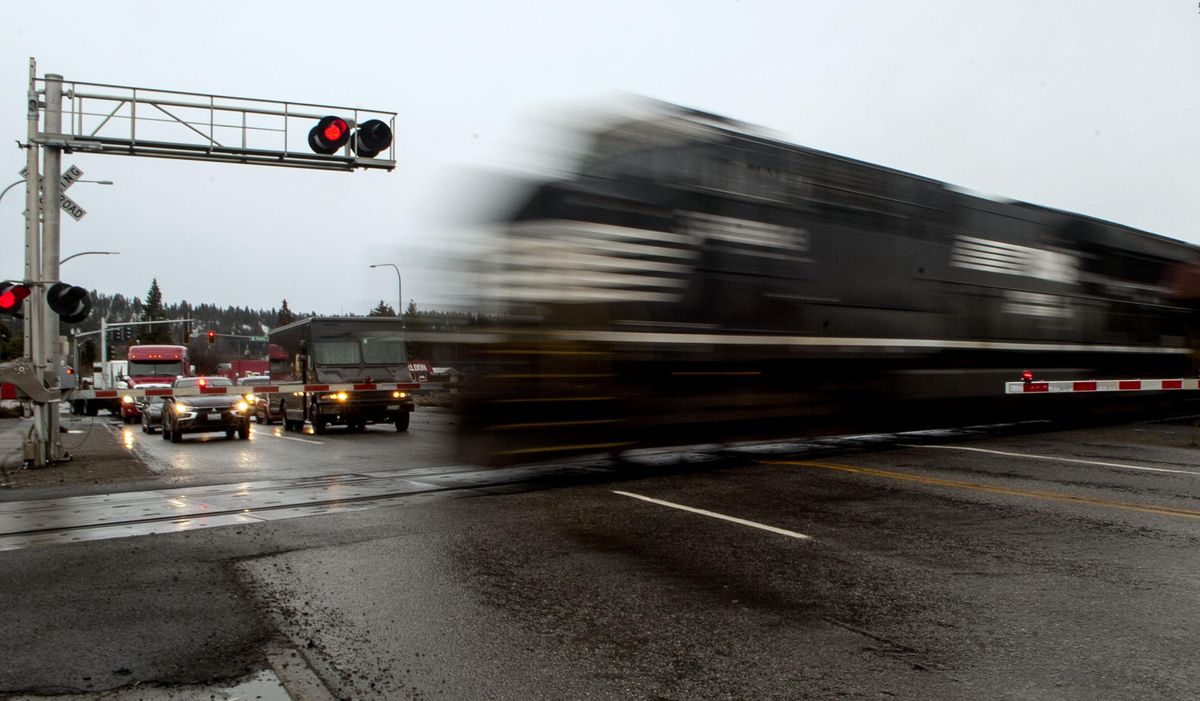Spokane Valley to replace Pines Road rail crossing with underpass

After Spokane Valley successfully secured $19 million for the Barker Road project to construct an overpass separating vehicle and rail traffic, the city is now setting its sights on improving a second rail crossing.
Spokane Valley is moving forward with plans to replace a rail crossing at Pines Road and BNSF tracks with an underpass and construct a roundabout or traffic signal at Pines Road and Trent Avenue.
The project would improve safety for vehicles, bicyclists and pedestrians as well as reduce noise from trains, according to the city.
More than 16,400 vehicles per day cross the tracks on Pines, which was rated the top road-rail conflict in the state, according to the Washington state Joint Transportation Committee.
Last year, the rail crossing caused more than 27,000 hours of vehicle delays and 27 collisions at the adjacent intersection at Trent Avenue and Pines Road, according to city documents.
An estimated 56 trains per day pass through the corridor, and it is projected that number will grow to 114 trains per day by 2035, according to the city.
The city hired HDR Engineering and David Evans and Associates last year to complete design work for the Pines Road project. The consulting firms presented two design options at a meeting at Spokane Valley City Hall on Thursday.
The first option diverts Pines Road to an underpass running under the rails parallel to and just east of the existing road, then intersects with a roundabout at Trent Avenue. The second design is similar, again diverting to the underpass, but places its roundabout farther to the east.
The consultants said that option two – at a $26 million price tag – would have less impact on residents because it would be built on vacant land and traffic could operate normally during construction.
The first option would require Trent Avenue to be lowered more than 10 feet and could cause significant traffic delays during construction. It also would cost about $3 million more than the second option, the consultants said.
East Valley School District Superintendent Kelly Shea said he prefers the second project design because it would reduce traffic backup from the intersection to Trent Elementary School.
“There’s such a short distance right now, that when traffic backs up our buses and our private vehicles cannot get in and out of our parking lot,” he said at the meeting. “So, option two would definitely be favorable to us.”
Spokane Valley has secured more than $5 million in combined city and grant funds for the project; construction would be done in 2023. The city has hired a federal lobbyist this year to assist with obtaining additional grant funds.
The Pines Road railroad bridge – once constructed – could unlock economic potential to develop vacant land in the area that’s zoned for industrial and commercial uses.
The 96-acre Pinecroft Business Park, located southeast of the rail crossing, has capacity to double its employee base and increase square footage of existing buildings from 500,000 to 900,000 square feet.
There’s been a significant uptick in traffic congestion along Pines Road over the past few years, said JoAnne Watts, director of commercial property management NW for Leavitt Capital Companies.
Watts, who is the property manager at Pinecroft Business Park, said infrastructure improvements on Pines Road could help employees get to their jobs more quickly and encourage Spokane Transit Authority to install more bus stops.
“We’re supportive of anything that helps employees get to their jobs easier,” she said. “Spokane is getting busier, and as we become a bigger city we have to have the infrastructure to support it. Construction will take awhile, but we’ll all benefit from the improvements.”
Higgins said the city is making infrastructure improvements in northeast Spokane Valley a priority.
In addition to the Pines and Barker railroad bridge projects, the city, in conjunction with the state, is planning to upgrade the Barker Road bridge over Interstate 90.
“So, we’ve got lots of work to do, and, it happens to be that the east side of the city is rapidly growing right now, so our work is cut out for us,” Higgins said.
The Spokane Valley City Council will decide on a design option for the Pines Road railroad bridge project at a future council meeting. Following the council’s decision, city staff will submit what’s called an “intersection control analysis” to the state to evaluate whether the project will include a traffic signal or roundabout.
City officials remain hopeful that once the project design progresses, the city will be competitive for grant funding.
“Every time we are successful in one of these projects, it’s like turning a key and opening another door to the success and growth to our city,” Higgins said. “It’s really pretty exciting.”